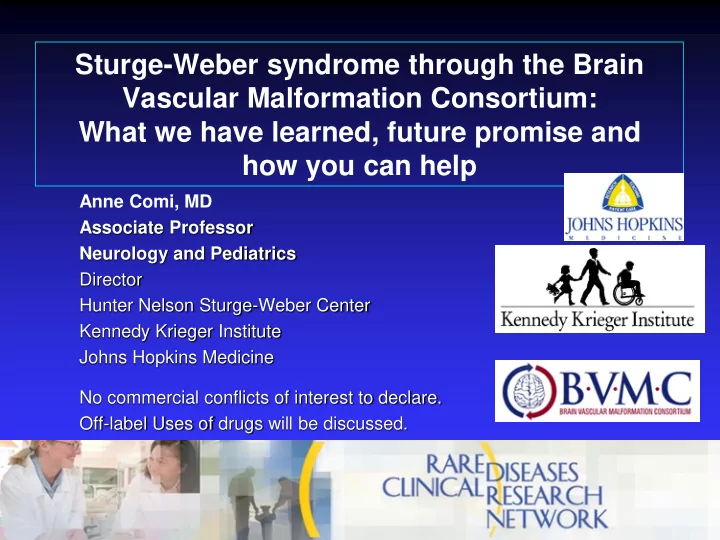

Sturge-Weber syndrome through the Brain Vascular Malformation Consortium: What we have learned, future promise and how you can help Anne Comi, MD Associate Professor Neurology and Pediatrics Director Hunter Nelson Sturge-Weber Center Kennedy Krieger Institute Johns Hopkins Medicine No commercial conflicts of interest to declare. Off-label Uses of drugs will be discussed.
Today’s Talk Define the Brain Vascular Malformation Consortium and its Mission Describe its SWS research to date and the results Relate the importance of these findings and some of the future work likely to build on these results Provide ways in which patients and families can speed the progress of research and the development of new and better treatment strategies
Acknowledgements Clinical Research: Kennedy Krieger Institute and Johns Hopkins Medicine Current Laboratory Research: Joshua Ewen -Jonathan Pevsner Larry Frelin Balaji Lakshmanan Matt Shirley Nathan Crone Joe Baugher Doris Lin Eboni Lance -Comi Lab Libby Shotwell Hunter Nelson Sturge-Weber Center Tatyana Verina Emily Germaine-Lee KKI Pediatric Endocrinology -Marsha Moses (Boston) Stacy Suskauer KKI Pediatric Med. Rehab -Doug Marchuk (Duke) Andy Zabel KKI Pediatric Neuropsychology Bernard Cohen JHH Pediatric Dermatology Funding from: Eric Kossoff JHH Pediatric Epilepsy Hunter’s Dream for a Cure Henry Jampel JHH Wilmer Eye Institute Private Donors Kira Lanier KKI Research Assistant BVMC and National Institutes of Cathy Bachur KKI Research Assistant Health Celebrate Hope Foundation Past Laura Hatfield and Adit Sreenivasan Jennifer Reeseman Mihee Bay
Goals of the BVMC To carry out multi-centered research better understand, diagnose and treat Cavernous Capillary Malformation Sturge-Weber syndrome Hereditary Hemorrhagic Telangiectasia
Aims of Sturge-Weber syndrome Project Aim 1: Develop a SWS National De- identified Database Aim 2: To develop new vascular urine biomarkers Aim 3: To discover the somatic mutation causing SWS Pilot project: SWS Biomarker development Training Project: Aspirin and Stimulant Experience at KKI center
Aim 1: National Database De-identified Database housed at University of South Florida SWF assisting in screening-subjects must have SWS brain involvement shown on MRI Consent and questionnaire can be done over phone OR at center visit Goal to gather data for study and for future research
Participating Centers Hunter Nelson Sturge-Weber Center at the Kennedy Krieger Institute/ Johns Hopkins (Comi) Wayne State University (Chugani) Nationwide Children’s Hospital (Lo) Thomas Jefferson University – Wills Eye Institute (Levin) Baylor College of Medicine, Texas Children’s Hospital (Wilfong)
National Database: Future Directions Working with the participating centers and PIs to summarize and publish data so far Current data will serve as pilot data for the renewal of the Consortium Grant application This database can be used in the future to recruit for studies.
Aim 2: Urine SWS biomarkers study Variability in severity and responses in SWS a challenge in treatment A good biomarker should be safe to do, not very expensive, and should be predictive of disease severity, progression or response A good biomarker is helpful for clinical trials and in clinical care of patients We collected urines and SWS neurologic scores from the same visits and compared to controls (KKI center only).
Urine Blood Vessel biomarkers in SWS: Recently published data MMP2 and MMP9 more likely to be urine of children and adults with SWS MMP9 levels were higher in females with SWS than in males Higher MMPs were associated with worse neurologic scores at the time of the clinical visit Higher bFGF levels were associated with improved clinical outcome a year after sample collection. (Adit et al. Vascular Med. 2013)
Urine SWS Biomarkers: Future directions We are continuing to study these biomarkers over time and relate them to the medication the subjects take an their neurologic scores We will propose in renewal to continue studying these biomarkers as we take next steps towards clinical trials.
Pilot Study: Other SWS biomarkers Quantitative EEG Transcranial doppler Medical rehabilitation scales Optical coherence tomography
Future of SWS Biomarkers Biomarkers will have an important role in future clinical trials. Enable us to have primary and secondary endpoints to measure and determine effectiveness of treatment. May become ways of safely monitoring patient clinical status and treatment reponses.
Aim 3: Evidence for a somatic mutation in SWS Localized asymmetric abnormalities in vascular development of brain, eye and skin (Happle, J Am Acad Derm, 1987) Report of one of two monozygotic twins with SWS (Pedailles, Eur Neurol, 1993) Increased fibronectin expression in SWS PWS fibroblasts (Comi et al, Ped Res 2003) Chromosomal abnormalities reported in 2 fibroblast cultures from SWS affected regions (Huq et al, Neurology 2002) ( Sabin FR. Carnegie Contrib Embryol, 1917)
Drs. Marchuk, Comi, and Pevsner contributed equally to this article.
Signaling Pathways in Melanoma and SWS and PWS Adapted from CCR Review 2011
Thoughts The somatic mosaic mutation in GNAQ results in hyper-activation of pathways important in many cell functions. A great deal is known about these pathways. The same mutation, ocurring in a different cell type, at a different time in development, results in a vascular malformation instead of a tumor.
How can you help? National De-identified database: We urgently need participants to contribute to the national de-identified database. Please see SWF staff or myself if you are interested. Participate in research where possible. Tissue donation is critical. We know the gene, but still need tissue to answer really important next questions. Donate. Have a fundraiser. Every donation counts and the need is great!
The Brain Vascular Malformation Consortium has made significant advances in our understanding of SWS and laying the foundation for clinical trials and new future treatments. Our multi-centered consortium will lay the foundation for future clinical trials. New promising neurologic biomarkers are currently being developed. ….. and our work continues . With the discovery of the somatic mutation causing SWS we are standing at the dawn of a new day for SWS- the promise is great… Thank You!
Recommend
More recommend